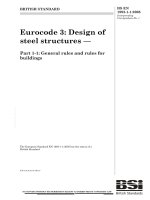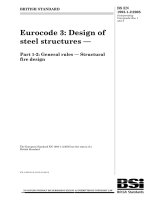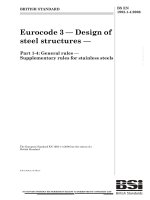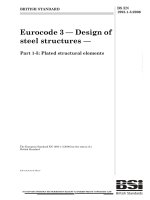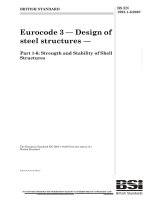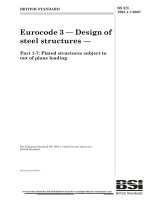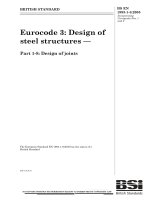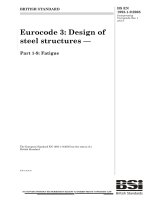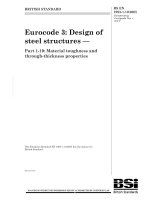Tiêu chuẩn Châu Âu EC9: Kết cấu nhôm phần 1.3: Kết cấu chịu mỏi (Eurocode9 BS EN1999 1 3 e 2007 structures susceptible to fatigue Design of aluminum structures part 1.3: Structures susceptible to fatigue)
Bạn đang xem bản rút gọn của tài liệu. Xem và tải ngay bản đầy đủ của tài liệu tại đây (955.11 KB, 100 trang )
BRITISH STANDARD
Eurocode 9: Design of
aluminium structures —
Licensed copy:PONTYPRIDD COLLEGE, 12/01/2008, Uncontrolled Copy, © BSI
Part 1-3: Structures susceptible to
fatigue
The European Standard EN 1999-1-3:2007 has the status of a
British Standard
ICS 77.150.10; 91.010.30; 91.080.10
12 &23<,1* :,7+287 %6, 3(50,66,21 (;&(37 $6 3(50,77(' %< &23<5,*+7 /$:
BS EN
1999-1-3:2007
BS EN 1999-1-3:2007
National foreword
This British Standard is the UK implementation of EN 1999-1-3:2007. It
supersedes DD ENV 1999-2:2000 which is withdrawn. Details of superseded
British Standards are given in the table below.
The structural Eurocodes are divided into packages by grouping Eurocodes for
each of the main materials: concrete, steel, composite concrete and steel,
timber, masonry and aluminium; this is to enable a common date of
withdrawal (DOW) for all the relevant parts that are needed for a particular
design. The conflicting national standards will be withdrawn at the end of the
coexistence period, after all the EN Eurocodes of a package are available.
Licensed copy:PONTYPRIDD COLLEGE, 12/01/2008, Uncontrolled Copy, © BSI
Following publication of the EN, there is a period allowed for national
calibration during which the National Annex is issued, followed by a further
coexistence period of a maximum three years. During the coexistence period
Member States will be encouraged to adapt their national provisions to
withdraw conflicting national rules before the end of the coexistence period in
March 2010. At the end of this coexistence period, the national standard(s) will
be withdrawn.
In the UK, the following national standards are superseded by the Eurocode 9
series. These standards will be withdrawn on a date to be announced.
Eurocode
Superseded British Standards
EN 1999-1-1
BS 8118-2:1991
DD ENV 1999-1-1:2000
BS 8118-1:1991 (partial)
DD ENV 1999-1-2:2000
DD ENV 1999-2:2000
BS 8118-1:1991 (partial)
BS 8118-1:1991 (partial)
None
EN 1999-1-2
EN 1999-1-3
EN 1999-1-4
EN 1999-1-5
The UK participation in its preparation was entrusted by Technical Committee
B/525, Building and civil engineering structures, to Subcommittee B/525/9,
Structural use of aluminium.
A list of organizations represented on this committee can be obtained on
request to its secretary.
Where a normative part of this EN allows for a choice to be made at the
national level, the range and possible choice will be given in the normative text,
and a note will qualify it as a Nationally Determined Parameter (NDP). NDPs
can be a specific value for a factor, a specific level or class, a particular method
or a particular application rule if several are proposed in the EN.
To enable EN 1999-1-3 to be used in the UK, the NDPs will be published in a
National Annex, which will be made available by BSI in due course, after
public consultation has taken place.
This publication does not purport to include all the necessary provisions of a
contract. Users are responsible for its correct application.
Compliance with a British Standard cannot confer immunity from
legal obligations.
This British Standard was
published under the authority
of the Standards Policy and
Strategy Committee
on 31 August 2007
© BSI 2007
ISBN 978 0 580 50929 2
Amendments issued since publication
Amd. No.
Date
Comments
EUROPEAN STANDARD
EN 1999-1-3
NORME EUROPÉENNE
EUROPÄISCHE NORM
May 2007
ICS 91.010.30; 91.080.10
Supersedes ENV 1999-2:1998
English Version
Eurocode 9: Design of aluminium structures - Part 1-3:
Structures susceptible to fatigue
Licensed copy:PONTYPRIDD COLLEGE, 12/01/2008, Uncontrolled Copy, © BSI
Eurocode 9: Calcul des structures en aluminium - Partie 13: Structures sensibles à la fatigue
Eurocode 9: Bemessung und Konstruktion von
Aluminiumtragwerken - Teil 1-3: Ermüdungsbeanspruchte
Tragwerke
This European Standard was approved by CEN on 25 November 2006.
CEN members are bound to comply with the CEN/CENELEC Internal Regulations which stipulate the conditions for giving this European
Standard the status of a national standard without any alteration. Up-to-date lists and bibliographical references concerning such national
standards may be obtained on application to the CEN Management Centre or to any CEN member.
This European Standard exists in three official versions (English, French, German). A version in any other language made by translation
under the responsibility of a CEN member into its own language and notified to the CEN Management Centre has the same status as the
official versions.
CEN members are the national standards bodies of Austria, Belgium, Bulgaria, Cyprus, Czech Republic, Denmark, Estonia, Finland,
France, Germany, Greece, Hungary, Iceland, Ireland, Italy, Latvia, Lithuania, Luxembourg, Malta, Netherlands, Norway, Poland, Portugal,
Romania, Slovakia, Slovenia, Spain, Sweden, Switzerland and United Kingdom.
EUROPEAN COMMITTEE FOR STANDARDIZATION
COMITÉ EUROPÉEN DE NORMALISATION
EUROPÄISCHES KOMITEE FÜR NORMUNG
Management Centre: rue de Stassart, 36
© 2007 CEN
All rights of exploitation in any form and by any means reserved
worldwide for CEN national Members.
B-1050 Brussels
Ref. No. EN 1999-1-3:2007: E
EN 1999-1-3:2007 (E)
Contents
Page
Licensed copy:PONTYPRIDD COLLEGE, 12/01/2008, Uncontrolled Copy, © BSI
Foreword..............................................................................................................................................................5
1
1.1
1.1.1
1.1.2
1.2
1.3
1.4
1.5
1.5.1
1.5.2
1.6
1.7
1.7.1
1.7.2
1.7.3
General....................................................................................................................................................9
Scope ......................................................................................................................................................9
Scope of EN 1999...................................................................................................................................9
Scope of EN 1999-1-3 ............................................................................................................................9
Normative references ..........................................................................................................................10
Assumptions ........................................................................................................................................10
Distinction between principles and application rules......................................................................11
Terms and definitions .........................................................................................................................11
General..................................................................................................................................................11
Additional terms used in EN 1999-1-3 ...............................................................................................11
Symbols ................................................................................................................................................14
Specification for execution.................................................................................................................16
Execution specification.......................................................................................................................16
Operation manual ................................................................................................................................16
Inspection and maintenance manual.................................................................................................16
2
2.1
2.1.1
2.2
2.2.1
2.2.2
2.2.3
2.3
2.3.1
2.3.2
2.3.3
2.4
Basis of design ....................................................................................................................................17
General..................................................................................................................................................17
Basic requirements..............................................................................................................................17
Procedures for fatigue design............................................................................................................17
Safe life design.....................................................................................................................................17
Damage tolerant design ......................................................................................................................17
Design assisted by testing .................................................................................................................18
Fatigue loading ....................................................................................................................................18
Sources of fatigue loading..................................................................................................................18
Derivation of fatigue loading ..............................................................................................................18
Equivalent fatigue loading ..................................................................................................................19
Partial factors for fatigue loads..........................................................................................................19
3
Materials, constituent products and connecting devices ...............................................................20
4
Durability ..............................................................................................................................................21
5
5.1
5.1.1
5.1.2
5.1.3
5.2
5.2.1
5.2.2
5.2.3
5.2.4
5.3
5.3.1
5.3.2
5.3.3
5.3.4
5.4
5.4.1
5.4.2
5.5
5.6
Structural analysis...............................................................................................................................22
Global analysis.....................................................................................................................................22
General..................................................................................................................................................22
Use of beam elements .........................................................................................................................23
Use of membrane, shell and solid elements.....................................................................................23
Types of stresses.................................................................................................................................24
General..................................................................................................................................................24
Nominal stresses .................................................................................................................................24
Modified nominal stresses..................................................................................................................24
Hot spot stresses.................................................................................................................................25
Derivation of stresses .........................................................................................................................27
Derivation of nominal stresses ..........................................................................................................27
Derivation of modified nominal stresses ..........................................................................................27
Derivation of hot spot stresses ..........................................................................................................28
Stress orientation ................................................................................................................................28
Stress ranges for specific initiation sites .........................................................................................28
Parent material, welds, and mechanically fastened joints ..............................................................28
Fillet and partial penetration butt welds............................................................................................28
Adhesive bonds ...................................................................................................................................29
Castings................................................................................................................................................29
2
Licensed copy:PONTYPRIDD COLLEGE, 12/01/2008, Uncontrolled Copy, © BSI
EN 1999-1-3:2007 (E)
5.7
5.8
5.8.1
5.8.2
Stress spectra......................................................................................................................................29
Calculation of equivalent stress range for standardised fatigue load models .............................29
General .................................................................................................................................................29
Design value of stress range .............................................................................................................30
6
6.1
6.1.1
6.1.2
6.1.3
6.2
6.2.1
6.2.2
6.2.3
6.2.4
6.3
6.3.1
6.3.2
6.3.3
6.3.4
6.3.5
6.3.6
6.4
6.5
Fatigue resistance and detail categories ..........................................................................................31
Detail categories..................................................................................................................................31
General .................................................................................................................................................31
Factors affecting detail category .......................................................................................................31
Constructional details.........................................................................................................................31
Fatigue strength data ..........................................................................................................................32
Classified constructional details .......................................................................................................32
Unclassified details .............................................................................................................................34
Adhesively bonded joints ...................................................................................................................34
Determination of the reference hot spot strength values ...............................................................34
Effect of mean stress ..........................................................................................................................34
General .................................................................................................................................................34
Plain material and mechanically fastened joints .............................................................................35
Welded joints .......................................................................................................................................35
Adhesive joints .................................................................................................................................... 35
Low endurance range .........................................................................................................................35
Cycle counting for R-ratio calculations ............................................................................................35
Effect of exposure conditions............................................................................................................35
Improvement techniques ....................................................................................................................36
Annex A [normative]: Basis for calculation of fatigue resistance ..............................................................37
A.1
General .................................................................................................................................................37
A.1.1 Influence of fatigue on design ...........................................................................................................37
A.1.2 Mechanism of failure...........................................................................................................................37
A.1.3 Potential sites for fatigue cracking....................................................................................................37
A.1.4 Conditions for fatigue susceptibility .................................................................................................38
A.2
Safe life design ....................................................................................................................................38
A.2.1 Prerequisites for safe life design.......................................................................................................38
A.2.2 Cycle counting..................................................................................................................................... 39
A.2.3 Derivation of stress spectrum............................................................................................................39
A.3
Damage tolerant design......................................................................................................................42
A.3.1 Prerequisites for damage tolerant design ........................................................................................42
A.3.2 Determination of inspection strategy for damage tolerant design ................................................42
Annex B [informative]: Guidance on assessment of crack growth by fracture mechanics.....................45
B.1
Scope ....................................................................................................................................................45
B.2
Principles .............................................................................................................................................45
B.2.1 Flaw dimensions..................................................................................................................................45
B.2.2 Crack growth relationship ..................................................................................................................46
B.3
Crack growth data A and m................................................................................................................46
B.4
Geometry function y............................................................................................................................48
B.5
Integration of crack growth ................................................................................................................48
B.6
Assessment of maximum crack size a2 ............................................................................................48
Annex C [informative]: Testing for fatigue design........................................................................................58
C.1
General .................................................................................................................................................58
C.2
Derivation of action loading data.......................................................................................................58
C.2.1 Fixed structures subject to mechanical action ................................................................................58
C.2.2 Fixed structures subject to actions due to exposure conditions ..................................................59
C.2.3 Moving structures ...............................................................................................................................59
C.3
Derivation of stress data ....................................................................................................................59
C.3.1 Component test data...........................................................................................................................59
C.3.2 Structure test data...............................................................................................................................60
C.3.3 Verification of stress history..............................................................................................................60
C.4
Derivation of endurance data.............................................................................................................60
C.4.1 Component testing..............................................................................................................................60
C.4.2 Full scale testing ................................................................................................................................. 61
3
EN 1999-1-3:2007 (E)
C.4.3
C.5
C.6
Acceptance...........................................................................................................................................61
Crack growth data................................................................................................................................64
Reporting ..............................................................................................................................................64
Annex D [informative]: Stress analysis ..........................................................................................................65
D.1
Use of finite elements for fatigue analysis........................................................................................65
D.1.1 Element types.......................................................................................................................................65
D.1.2 Further guidance on use of finite elements ......................................................................................66
D.2
Stress concentration factors ..............................................................................................................66
D.3
Limitation of fatigue induced by repeated local buckling ...............................................................68
Annex E [informative]: Adhesively bonded joints.........................................................................................69
Licensed copy:PONTYPRIDD COLLEGE, 12/01/2008, Uncontrolled Copy, © BSI
Annex F [informative]: Low cycle fatigue range............................................................................................71
F.1
Introduction ..........................................................................................................................................71
F.2
Modification to ∆σ-N curves...............................................................................................................71
F.3
Test data ...............................................................................................................................................71
Annex G [informative]: Influence of R-ratio ...................................................................................................73
G.1
Enhancement of fatigue strength.......................................................................................................73
G.2
Enhancement cases ............................................................................................................................73
G.2.1 Case 1 ...................................................................................................................................................73
G.2.2 Case 2 ...................................................................................................................................................74
G.2.3 Case 3 ...................................................................................................................................................74
Annex H [informative]: Fatigue strength improvement of welds.................................................................75
H.1
General..................................................................................................................................................75
H.2
Machining or grinding .........................................................................................................................75
H.3
Dressing by TIG or plasma .................................................................................................................76
H.4
Peening .................................................................................................................................................76
Annex I [informative]: Castings.......................................................................................................................77
I.1
General..................................................................................................................................................77
I.2
Fatigue strength data ..........................................................................................................................77
I.2.1
Plain castings.......................................................................................................................................77
I.2.2
Welded material ...................................................................................................................................77
I.2.3
Mechanically joined castings .............................................................................................................77
I.2.4
Adhesively bonded castings ..............................................................................................................78
I.3
Quality requirements ...........................................................................................................................78
Annex J [informative]: Detail category tables ...............................................................................................79
J.1
General..................................................................................................................................................79
Annex K [informative]: Hot spot reference detail method............................................................................95
Bibliography ......................................................................................................................................................96
4
EN 1999-1-3:2007 (E)
Foreword
This document (EN 1999-1-3:2007) has been prepared by Technical Committee CEN/TC 250 “Structural
Eurocodes”, the secretariat of which is held by BSI.
This European Standard shall be given the status of a national standard, either by publication of an identical
text or by endorsement, at the latest by November 2007, and conflicting national standards shall be withdrawn
at the latest by March 2010.
This European Standard supersedes ENV 1999-2: 1998.
Licensed copy:PONTYPRIDD COLLEGE, 12/01/2008, Uncontrolled Copy, © BSI
According to the CEN/CENELEC Internal Regulations, the national standards organizations of the following
countries are bound to implement this European Standard:
Austria, Belgium, Bulgaria, Cyprus, Czech Republic, Denmark, Estonia, Finland, France, Germany, Greece,
Hungary, Iceland, Ireland, Italy, Latvia, Lithuania, Luxemburg, Malta, Netherlands, Norway, Poland, Portugal,
Romania, Slovakia, Slovenia, Spain, Sweden, Switzerland and the United Kingdom.
Background to the Eurocode programme
In 1975, the Commission of the European Community decided on an action programme in the field of
construction, based on article 95 of the Treaty. The objective of the programme was the elimination of
technical obstacles to trade and the harmonisation of technical specifications.
Within this action programme, the Commission took the initiative to establish a set of harmonised technical
rules for the design of construction works, which in a first stage would serve as an alternative to the national
rules in force in the Member States and, ultimately, would replace them.
For fifteen years, the Commission, with the help of a Steering Committee with Representatives of Member
States, conducted the development of the Eurocodes programme, which led to the first generation of
European codes in the 1980s.
In 1989, the Commission and the Member States of the EU and EFTA decided, on the basis of an
agreement 1) between the Commission and CEN, to transfer the preparation and the publication of the
Eurocodes to the CEN through a series of Mandates, in order to provide them with a future status of European
Standard (EN). This links de facto the Eurocodes with the provisions of all the Council’s Directives and/or
Commission’s Decisions dealing with European standards (e.g. the Council Directive 89/106/EEC on
construction products – CPD – and Council Directives 93/37/EEC, 92/50/EEC and 89/440/EEC on public
works and services and equivalent EFTA Directives initiated in pursuit of setting up the internal market).
The Structural Eurocode programme comprises the following standards generally consisting of a number of
Parts:
EN 1990 Eurocode 0: Basis of structural design
EN 1991 Eurocode 1: Actions on structures
EN 1992 Eurocode 2: Design of concrete structures
EN 1993 Eurocode 3: Design of steel structures
1) Agreement between the Commission of the European Communities and the European Committee for Standardisation (CEN)
concerning the work on EUROCODES for the design of building and civil engineering works (BC/CEN/03/89).
5
EN 1999-1-3:2007 (E)
EN 1994 Eurocode 4: Design of composite steel and concrete structures
EN 1995 Eurocode 5: Design of timber structures
EN 1996 Eurocode 6: Design of masonry structures
EN 1997 Eurocode 7: Geotechnical design
EN 1998 Eurocode 8: Design of structures for earthquake resistance
EN 1999 Eurocode 9: Design of aluminium structures
Eurocode standards recognise the responsibility of regulatory authorities in each Member State and have
safeguarded their right to determine values related to regulatory safety matters at national level where these
continue to vary from State to State.
Status and field of application of Eurocodes
Licensed copy:PONTYPRIDD COLLEGE, 12/01/2008, Uncontrolled Copy, © BSI
The Member States of the EU and EFTA recognise that Eurocodes serve as reference documents for the
following purposes:
As a means to prove compliance of building and civil engineering works with the essential requirements
of Council Directive 89/106/EEC, particularly Essential Requirement N°1 - Mechanical resistance and
stability - and Essential Requirement N°2 - Safety in case of fire;
as a basis for specifying contracts for construction works and related engineering services;
as a framework for drawing up harmonised technical specifications for construction products (ENs and
ETAs).
The Eurocodes, as far as they concern the construction works themselves, have a direct relationship with the
Interpretative Documents2) referred to in Article 12 of the CPD, although they are of a different nature from
harmonised product standard3) . Therefore, technical aspects arising from the Eurocodes work need to be
adequately considered by CEN Technical Committees and/or EOTA Working Groups working on product
standards with a view to achieving a full compatibility of these technical specifications with the Eurocodes.
The Eurocode standards provide common structural design rules for everyday use for the design of whole
structures and component products of both a traditional and an innovative nature. Unusual forms of
construction or design conditions are not specifically covered and additional expert consideration will be
required by the designer in such cases.
2) According to Art. 3.3 of the CPD, the essential requirements (ERs) shall be given concrete form in interpretative documents for the
creation of the necessary links between the essential requirements and the mandates for hENs and ETAGs/ETAs.
3)
According to Art. 12 of the CPD the interpretative documents shall:
a) give concrete form to the essential requirements by harmonising the terminology and the technical bases and indicating classes or
levels for each requirement where necessary;
b) indicate methods of correlating these classes or levels of requirement with the technical specifications, e.g. methods of calculation
and of proof,technical rules for project design,etc.;
c) serve as a reference for the establishment of harmonised standards and guidelines for European technical approvals. The
Eurocodes, de facto, play a similar role in the field of the ER 1 and a part of ER 2.
6
EN 1999-1-3:2007 (E)
National Standards implementing Eurocodes
The National Standards implementing Eurocodes will comprise the full text of the Eurocode (including any
annexes), as published by CEN, which may be preceded by a National title page and National foreword, and
may be followed by a National Annex (informative).
Licensed copy:PONTYPRIDD COLLEGE, 12/01/2008, Uncontrolled Copy, © BSI
The National Annex (informative) may only contain information on those parameters which are left open in the
Eurocode for national choice, known as Nationally Determined Parameters, to be used for the design of
buildings and civil engineering works to be constructed in the country concerned, i.e.:
Values for partial factors and/or classes where alternatives are given in the Eurocode;
values to be used where a symbol only is given in the Eurocode;
geographical and climatic data specific to the Member State, e.g. snow map;
the procedure to be used where alternative procedures are given in the Eurocode;
references to non-contradictory complementary information to assist the user to apply the Eurocode.
Links between Eurocodes and product harmonised technical specifications (ENs and ETAs)
There is a need for consistency between the harmonised technical specifications for construction products
and the technical rules for works4) . Furthermore, all the information accompanying the CE Marking of the
construction products which refer to Eurocodes should clearly mention which Nationally Determined
Parameters have been taken into account.
Additional information specific to EN 1999-1-3
EN 1999 is intended to be used with Eurocodes EN 1990 – Basis of Structural Design, EN 1991 – Actions on
structures and EN 1992 to EN 1999, where aluminium structures or aluminium components are referred to.
EN 1999-1-3 is one of five parts EN 1999-1-1 to EN 1999-1-5 each addressing specific aluminium
components, limit states or type of structure. EN 1999-1-3 describes the principles, requirements and rules for
the structural design of aluminium components and structures subjected to fatigue actions.
Numerical values for partial factors and other reliability parameters are recommended as basic values that
provide an acceptable level of reliability. They have been selected assuming that an appropriate level of
workmanship and quality management applies.
National Annex for EN 1999-1-3
This standard gives alternative procedures, values and recommendations for classes with NOTEs indicating
where national choices may have to be made. Therefore the National Standard implementing EN 1999-1-1
should have a National Annex containing all Nationally Determined Parameters to be used for the design of
aluminium structures to be constructed in the relevant country.
4) See Art.3.3 and Art.12 of the CPD, as well as clauses 4.2, 4.3.1, 4.3.2 and 5.2 of ID 1. Construction products which refer to
Eurocodes should clearly mention which Nationally Determined Parameters have been taken into account.
7
EN 1999-1-3:2007 (E)
Licensed copy:PONTYPRIDD COLLEGE, 12/01/2008, Uncontrolled Copy, © BSI
National choice is allowed in EN 1999-1-3 through clauses:
2.1 (1)
2.2.1 (3)
2.3.1 (3)
2.3.2 (6)
2.4 (1)
3 (1)
4 (2)
5.8.1 (1)
5.8.2 (1)
6.1.3 (1)
6.2.1(2)
6.2.1 (7)
6.2.1 (11)
6.2.4 (1)
A.3.1 (1)
E (5)
E (7)
I.2.2 (1)
I.2.3.2 (1)
I.2.4 (1).
8
EN 1999-1-3:2007 (E)
1
General
1.1 Scope
1.1.1
Scope of EN 1999
(1) P EN 1999 applies to the design of buildings and civil engineering and structural works in aluminium. It
complies with the principles and requirements for the safety and serviceability of structures, the basis of their
design and verification that are given in EN 1990 – Basis of structural design.
(2) EN 1999 is only concerned with requirements for resistance, serviceability, durability and fire resistance of
aluminium structures. Other requirements, e.g. concerning thermal or sound insulation, are not considered.
Licensed copy:PONTYPRIDD COLLEGE, 12/01/2008, Uncontrolled Copy, © BSI
(3) EN 1999 is intended to be used in conjunction with:
EN 1990 Basis of structural design
EN 1991 Actions on structures
European Standards for construction products relevant for aluminium structures
EN 1090-1: Execution of steel structures and aluminium structures – Part 1: Conformity assessment of
structural components5)
EN 1090-3: Execution of steel structures and aluminium structures – Part 3: Technical requirements for
aluminium structures6)
(4) EN 1999 is subdivided in five parts:
EN 1999-1-1 Design of Aluminium Structures: General structural rules
EN 1999-1-2 Design of Aluminium Structures: Structural fire design
EN 1999-1-3 Design of Aluminium Structures: Structures susceptible to fatigue
EN 1999-1-4 Design of Aluminium Structures: Cold-formed structural sheeting
EN 1999-1-5 Design of Aluminium Structures: Shell structures
1.1.2
Scope of EN 1999-1-3
(1) EN 1999-1-3 gives the basis for the design of aluminium alloy structures with respect to the limit state of
fracture induced by fatigue.
(2) EN 1999-1-3 gives rules for:
Safe life design;
damage tolerant design;
design assisted by testing.
5)
To be published
6)
To be published
9
EN 1999-1-3:2007 (E)
(3) EN 1999-1-3 is intended to be used in conjunction with EN 1090-3 “Technical requirements for the
execution of aluminium structures” which contains the requirements necessary for the design assumptions to
be met during execution of components and structures.
(4) EN 1999-1-3 does not cover pressurised containment vessels or pipe-work.
Licensed copy:PONTYPRIDD COLLEGE, 12/01/2008, Uncontrolled Copy, © BSI
(5) The following subjects are dealt with in EN 1999-1-3:
Section 1:
General
Section 2:
Basis of design
Section 3:
Materials, constituent products and connecting devices
Section 4:
Durability
Section 5:
Structural analysis
Section 6:
Ultimate limit state of fatigue
Annex A:
Basis for calculation of fatigue resistance [normative]
Annex B:
Guidance on assessment by fracture mechanics [informative]
Annex C:
Testing for fatigue design [informative]
Annex D:
Stress analysis [informative]
Annex E:
Adhesively bonded joints [informative]
Annex F:
Low cycle fatigue range [informative]
Annex G:
Influence of R-ratio [informative]
Annex H:
Fatigue strength improvement of welds [informative]
Annex I:
Castings [informative]
Annex J:
Detail category tables [informative]
Annex K:
Hot spot reference detail method [informative]
Bibliography
1.2 Normative references
(1) The normative references of EN 1999-1-1 apply.
1.3 Assumptions
(1) P The general assumptions of EN 1990, 1.3 apply.
(2) P The provisions of EN 1999-1-1, 1.8 apply.
(3) P The design procedures are valid only when the requirements for execution in EN 1090-3 or other
equivalent requirements are complied with.
10
EN 1999-1-3:2007 (E)
1.4 Distinction between principles and application rules
(1) P The rules in EN 1990, 1.4 apply.
1.5 Terms and definitions
1.5.1
General
(1) The rules in EN 1990, 1.5 apply.
1.5.2
Additional terms used in EN 1999-1-3
(1) For the purpose of this European Standard the following terms and definitions in addition to those defined
in EN 1990 and EN 1999-1-1 apply.
Licensed copy:PONTYPRIDD COLLEGE, 12/01/2008, Uncontrolled Copy, © BSI
1.5.2.1
fatigue
weakening of a structural part, through crack initiation and propagation caused by repeated stress fluctuations
1.5.2.2
fatigue loading
a set of typical load events described by the positions or movements of actions, their variation in intensity and
their frequency and sequence of occurrence
1.5.2.3
loading event
a defined load sequence applied to the structure, which, for design purposes, is assumed to repeat at a given
frequency
1.5.2.4
nominal stress
a stress in the parent material adjacent to a potential crack location, calculated in accordance with simple
elastic strength of materials theory, i.e. assuming that plane sections remain plane and that all stress
concentration effects are ignored
1.5.2.5
modified nominal stress
A nominal stress increased by an appropriate geometrical stress concentration factor Kgt, to allow only for
geometric changes of cross section which have not been taken into account in the classification of a particular
constructional detail
1.5.2.6
geometric stress
also known as structural stress, is the elastic stress at a point, taking into account all geometrical
discontinuities, but ignoring any local singularities where the transition radius tends to zero, such as notches
due to small discontinuities, e.g. weld toes, cracks, crack like features, normal machining marks etc. It is in
principle the same stress parameter as the modified nominal stress, but generally evaluated by a different
method
1.5.2.7
geometric stress concentration factor
the ratio between the geometric stress evaluated with the assumption of linear elastic behaviour of the
material and the nominal stress
1.5.2.8
hot spot stress
the geometric stress at a specified initiation site in a particular type of geometry, such as a weld toe in an
angle hollow section joint, for which the fatigue strength, expressed in terms of the hot spot stress range, is
usually known
11
EN 1999-1-3:2007 (E)
1.5.2.9
stress history
a continuous chronological record, either measured or calculated, of the stress variation at a particular point in
a structure for a given period of time
1.5.2.10
stress turning point
the value of stress in a stress history where the rate of change of stress changes sign
1.5.2.12
stress peak
a turning point where the rate of change of stress changes from positive to negative
Licensed copy:PONTYPRIDD COLLEGE, 12/01/2008, Uncontrolled Copy, © BSI
1.5.2.12
stress valley
a turning point where the rate of change of stress changes from negative to positive
1.5.2.13
constant amplitude
relating to a stress history where the stress alternates between stress peaks and stress valleys of constant
values
1.5.2.14
variable amplitude
relating to any stress history containing more than one value of peak or valley stress
1.5.2.15
stress cycle
part of a constant amplitude stress history where the stress starts and finishes at the same value but, in doing
so passes through one stress peak and one stress valley (in any sequence). Also, a specific part of a variable
amplitude stress history as determined by a cycle counting method
1.5.2.16
cycle counting
the process of transforming a variable amplitude stress history into a spectrum of stress cycles, each with a
particular stress range, e.g. the 'Reservoir' method and the 'Rain flow' method
1.5.2.17
rainflow method
particular cycle counting method of producing a stress-range spectrum from a given stress history
1.5.2.18
reservoir method
particular cycle counting method of producing a stress-range spectrum from a given stress history
1.5.2.19
stress amplitude
half the value of the stress range
1.5.2.20
stress ratio
minimum stress divided by the maximum stress in a constant amplitude stress history or a cycle derived from
a variable amplitude stress history
1.5.2.21
stress intensity ratio
minimum stress intensity divided by the maximum stress intensity derived from a constant amplitude stress
history or a cycle from a variable amplitude stress history
12
EN 1999-1-3:2007 (E)
1.5.2.22
mean stress
the mean value of the algebraic sum of maximum and minimum stress values
1.5.2.23
stress range
the algebraic difference between the stress peak and the stress valley in a stress cycle
1.5.2.24
stress intensity range
the algebraic difference between the maximum stress intensity and the minimum stress intensity derived from
the stress peak and the stress valley in a stress cycle
Licensed copy:PONTYPRIDD COLLEGE, 12/01/2008, Uncontrolled Copy, © BSI
1.5.2.25
stress-range spectrum
histogram of the frequency of occurrence for all stress ranges of different magnitudes recorded or calculated
for a particular load event (also known as 'stress spectrum')
1.5.2.26
design spectrum
the total of all stress-range spectra relevant to the fatigue assessment
1.5.2.27
detail category
the designation given to a particular fatigue initiation site for a given direction of stress fluctuation in order to
indicate which fatigue strength curve is applicable for the fatigue assessment
1.5.2.28
endurance
the life to failure expressed in cycles, under the action of a constant amplitude stress history
1.5.2.29
fatigue strength curve
the quantitative relationship relating stress range and endurance, used for the fatigue assessment of a
category of constructional detail, plotted with logarithmic axes in this standard
1.5.2.30
reference fatigue strength
6
the constant amplitude stress range ∆σc for a particular detail category for an endurance NC = 2x10 cycles
1.5.2.31
constant amplitude fatigue limit
the stress range below which value all stress ranges in the design spectrum should lie for fatigue damage to
be ignored
1.5.2.32
cut-off limit
limit below which stress ranges of the design spectrum may be omitted from the cumulative damage
calculation
1.5.2.33
design life
the reference period of time for which a structure is required to perform safely with an acceptable probability
that structural failure by fatigue cracking will not occur
1.5.2.34
safe life
the period of time for which a structure is estimated to perform safely with an acceptable probability that failure
by fatigue cracking will not occur, when using the safe life design method
13
EN 1999-1-3:2007 (E)
1.5.2.35
damage tolerance
ability of the structure to accommodate fatigue cracking without structural failure or unserviceability
1.5.2.36
fatigue damage
the ratio of the number of cycles of a given stress range which is required to be sustained during a specified
period of service to the endurance of the constructional detail under the same stress range
1.5.2.37
miner's summation
the summation of the damage due to all cycles in a stress-range spectrum (or a design spectrum), based on
the Palmgren-Miner rule
Licensed copy:PONTYPRIDD COLLEGE, 12/01/2008, Uncontrolled Copy, © BSI
1.5.2.38
equivalent fatigue loading
a simplified loading, usually a single load applied a prescribed number of times in such a way that it may be
used in place of a more realistic set of loads, within a given range of conditions, to give an equivalent amount
of fatigue damage, to an acceptable level of approximation
1.5.2.39
equivalent stress range
the stress range at a constructional detail caused by the application of an equivalent fatigue load
1.5.2.40
equivalent constant amplitude loading
simplified constant amplitude loading causing the same fatigue damage effects as a series of actual variable
amplitude load events
1.6 Symbols
A
constant in the crack growth relationship
a
fillet weld throat
a
crack length
ac
crack width on surface
da/dN
crack growth rate (m/cycle)
D
fatigue damage value calculated for a given period of service
DL
fatigue damage value calculated for the full design life
Dlim
prescribed limit of the fatigue damage value
fv,adh
characteristic shear strength of adhesive
Kgt
geometric stress concentration factor
K
stress intensity factor
∆K
stress intensity range
kadh
fatigue strength factor for adhesive joints
14
EN 1999-1-3:2007 (E)
kF
number of standard deviations above mean predicted intensity of loading
kN
number of standard deviations above mean predicted number of cycles of loading
Ladh
effective length of adhesively bonded lap joints
ld
minimum detectable length of crack
lf
fracture critical length of crack
log
logarithm to base 10
m
inverse slope constant of log∆σ-logN fatigue strength curve, or respectively crack growth rate
Licensed copy:PONTYPRIDD COLLEGE, 12/01/2008, Uncontrolled Copy, © BSI
exponent
6
m1
value of m for N ≤ 5x10 cycles
m2
value of m for 5x10 < N ≤ 10 cycles
N
number (or total number) of stress range cycles
Ni
endurance under stress range ∆σi
NC
number of cycles (2x10 ) at which the reference fatigue strength is defined
ND
number of cycles (5x10 ) at which the constant amplitude fatigue limit is defined
NL
number of cycles (10 ) at which the cut-off limit is defined
ni
number of cycles of stress range ∆σi
P
probability
R
stress ratio
t
thickness
Ti
inspection interval
Tf
time for a crack to grow from a detectable size to a fracture critical size
TL
design life
TS
safe life
y
crack geometry factor in crack growth relationship
γFf
partial factor for fatigue load intensity
γMf
partial factor for fatigue strength
∆σ
nominal stress range (normal stress)
6
8
6
6
8
15
Licensed copy:PONTYPRIDD COLLEGE, 12/01/2008, Uncontrolled Copy, © BSI
EN 1999-1-3:2007 (E)
∆τ
effective shear stress range
∆σC
reference fatigue strength at 2x10 cycles (normal stress)
∆σD
constant amplitude fatigue limit
∆σE
equivalent constant amplitude stress range related to Nmax
∆σE,2
equivalent constant amplitude stress range related to 2x10 cycles
∆σL
cut-off limit
∆σR
fatigue strength (normal stress)
σmax, σmin
maximum and minimum values of the fluctuating stresses in a stress cycle
σm
mean stress.
6
6
1.7 Specification for execution
1.7.1
Execution specification
(1) The execution specification should include all requirements for material preparation, assembly, joining,
post treatment and inspection in order that the required fatigue strengths are achieved.
1.7.2
Operation manual
(1) The operation manual should include:
Details of the fatigue loading and the design life assumed in the design;
any necessary requirements to monitor loading intensity and frequency during service;
an instruction forbidding any modification of the structure, e.g. making of holes or welding, without
qualified analysis of any structural consequences;
instructions for dismantling and reassembly of parts, e.g. tightening of fasteners;
acceptable repair methods in the event of accidental damage in-service (e.g. dents, penetrations, tears,
etc).
1.7.3
Inspection and maintenance manual
(1) The maintenance manual should include a schedule of any necessary in-service inspection of fatigue
critical parts. In particular, where damage tolerant design has been used, this should include:
The methods of inspection;
the locations for inspection;
the frequency of inspections;
the maximum permissible crack size before correction is necessary;
details of methods of repair or replacement of fatigue cracked parts.
16
EN 1999-1-3:2007 (E)
2
Basis of design
2.1 General
2.1.1
Basic requirements
(1) P The aim of designing a structure against the limit state of fatigue is to ensure, with an acceptable level of
probability, that its performance is satisfactory during its entire design life, such that the structure shall not fail
by fatigue nor shall it be likely to require undue repair of damage caused by fatigue during the design life.
The design of aluminium structures against the limit state of fatigue may be based on one of following
methods:
a) Safe life design (see 2.2.1);
b) Damage tolerant design (see 2.2.2).
Licensed copy:PONTYPRIDD COLLEGE, 12/01/2008, Uncontrolled Copy, © BSI
Either of methods a) and b) may be supplemented or replaced by design assisted by testing (see 2.2.3).
NOTE
The National Annex may give rules for the application of the damage tolerant design method, see Annex A.
(2) The design rules in the other parts of EN 1999 apply.
2.2 Procedures for fatigue design
2.2.1
Safe life design
(1) This method is based on the calculation of damage during the structure's design life using standard lower
bound endurance data and an upper bound estimate of the fatigue loading. The method provides a
conservative estimate of fatigue life.
(2) The method involves prediction of the stress histories at potential initiation sites, followed by counting of
stress ranges and compilation of stress spectra. From this information an estimate of the design life is made
using the appropriate stress range endurance data for the constructional detail concerned. This method is
given in A.2.
(3) For safe life design the damage DL for all cycles using Miner's summation should fulfil the condition:
DL ≤ Dlim
(2.1)
where:
DL = ∑ n i / N i is calculated in accordance with the procedure given in A.2.
NOTE
2.2.2
The value of Dlim may be given in the National Annex. A recommended maximum value for Dlim is 1,0.
Damage tolerant design
(1) This method is based on monitoring fatigue crack growth by means of a mandatory inspection program.
NOTE
The method may be suitable for application where a safe life assessment shows that fatigue has a significant effect on
design economy and where a higher risk of fatigue cracking during the design life may be justified than is permitted using safe life design
principles. The method is intended to result in the same reliability level as obtained by using the method of safe life design.
(2) The method involves the determination of the minimum detectable crack size at potential initiation sites.
The stress histories at the sites, followed by counting of stress intensity ranges and compilation of stress
intensity spectra are calculated. This information is used with a crack growth relationship for the alloy to
17
EN 1999-1-3:2007 (E)
calculate the crack growth rate. The time taken for the crack to grow to a maximum safe crack size is
estimated and an inspection regime specified accordingly. The method and conditions for its application are
given in A.3.
NOTE
2.2.3
Recommendations for crack growth data are given in Annex B.
Design assisted by testing
(1) This method should be used where the necessary loading data, response data, fatigue strength data or
crack growth data are not available from standards or other sources for a particular application, and for
optimisation of constructional details. Test data should only be used in lieu of standard data on condition that
they are obtained and applied under controlled conditions.
NOTE
Verification of design by testing should be carried out in accordance with Annex C.
2.3 Fatigue loading
2.3.1
Sources of fatigue loading
Licensed copy:PONTYPRIDD COLLEGE, 12/01/2008, Uncontrolled Copy, © BSI
(1) P All sources of fluctuating stress in the structure shall be identified.
(2) The following sources of fluctuating stresses should be considered:
a)
Superimposed moving loads, including vibrations from machinery in stationary structures;
b)
loads due to exposure conditions such as wind, waves, etc.;
c)
acceleration forces in moving structures;
d)
dynamic response due to resonant effects;
NOTE
For limitation of fatigue induced by repeated local buckling see D.3.
e) temperature changes.
(3) The fatigue load should be obtained from EN 1991 or other relevant European standard.
NOTE 1
The action parameters as given in EN 1991 are either
Qmax, nmax, standardized spectrum or
QE,n max related to nmax or
QE,2 corresponding to n = NC = 2x106 cycles.
Dynamic effects are included in these parameters unless otherwise stated.
NOTE 2
2.3.2
The National Annex may give rules for the determination of the fatigue load for cases not covered by a European standard.
Derivation of fatigue loading
(1) In addition to the fatigue load standards the following clauses should be considered:
(2) Load for fatigue should normally be described in terms of a design load spectrum, which defines a range of
intensities of a specific live load event and the number of times that each intensity level is applied during the
structure's design life. If two or more independent live load events are likely to occur then it will be necessary
to specify the phasing between them.
18
EN 1999-1-3:2007 (E)
(3) Realistic assessment of the fatigue load is crucial to the calculation of the life of the structure. Where no
published data for live load exist, resort should be made to obtaining data from existing structures subjected to
similar effects.
(4) By recording continuous strain or deflection measurements over a suitable sampling period, load data
should be inferred by subsequent analysis of the response. Particular care should be taken to assess dynamic
magnification effects where load frequencies are close to one of the natural frequencies of the structure.
NOTE
Further guidance is given in Annex C.
(5) The design load spectrum should be selected on the basis that it is an upper bound estimate of the
accumulated service conditions over the full design life of the structure. Account should be taken of all likely
operational and exposure condition effects arising from the foreseeable usage of the structure during that
period.
(6) The confidence limit to be used for the intensity of the design load spectrum should be based on the mean
predicted value plus kF standard deviations. The confidence limit to be used for the number of cycles in the
design load spectrum should be based on the mean predicted value plus kN standard deviations.
Licensed copy:PONTYPRIDD COLLEGE, 12/01/2008, Uncontrolled Copy, © BSI
NOTE
Values of kF and kN may be defined in the National Annex. The numerical values kF = 2, and kN = 2 are recommended. See
also NOTE 2 under 2.4 (1).
2.3.3
Equivalent fatigue loading
(1) A simplified equivalent fatigue load may be used if the following conditions are satisfied:
a)
The structure falls within the range of basic structural forms and size for which the equivalent fatigue load
was originally derived;
b)
the real fatigue load is of similar intensity and frequency and is applied in a similar way to that assumed in
the derivation of the equivalent fatigue load;
c)
the values of m1, m2, ND and NL, see Figure 6.1, assumed in the derivation of equivalent fatigue load are
the same as those appropriate to the constructional detail being assessed.
NOTE
Some equivalent fatigue loads may have been derived assuming a simple continuous slope where m2 = m1 and ∆σL = 0. For
many applications involving numerous low amplitude cycles this will result in a very conservative estimate of life.
d)
The dynamic response of the structure is sufficiently low that the resonant effects, which will be affected
by differences in mass, stiffness and damping coefficient, will have little effect on the overall Miner
summation.
(2) In the event that an equivalent fatigue load is derived specifically for an aluminium alloy structural
application, all the matters addressed in (1) above should be taken into account.
2.4 Partial factors for fatigue loads
(1) Where the fatigue loads FEk have been derived in accordance with the requirements of 2.3.1 (2) and 2.3.2
a partial factor should be applied to the loads to obtain the design load FEd.
FEd = γFf FEk
(2.2)
where:
γFf is the partial factor for fatigue loads.
NOTE 1
The partial factors may be defined in the National Annex. A value of γFf = 1,0 is recommended.
19
EN 1999-1-3:2007 (E)
NOTE 2
Where fatigue loads have been based on other confidence limits than those in 2.3.2(5), recommended values for partial
factors on loads are given in Table 2.1. Alternative values may be specified in the National Annex.
Table 2.1 —Recommended partial factors γFf for intensity and number of cycles in the fatigue load
spectrum
kF
3
γFf
kN = 0
kN = 2
0
1,5
1,4
1
1,3
1,2
2
1,1
1,0
Materials, constituent products and connecting devices
Licensed copy:PONTYPRIDD COLLEGE, 12/01/2008, Uncontrolled Copy, © BSI
(1) The design rules of EN 1999-1-3 apply to constituent products in components and structures as listed in
1999-1-1:05-2005 with the exception of the low strength alloys EN AW-3005, EN AW-3103, EN AW-5005, EN
AW-8011A in all tempers, and EN AW-6060 in temper T5.
NOTE 1
For the above mentioned low strength alloys and tempers no reliable fatigue data exist. The National Annex may give
fatigue data for such alloys and tempers, respectively. Tests to obtain the data should be carried out in accordance with Annex C.
NOTE 2
For castings see Annex I.
(2) EN 1999-1-3 covers components with open and hollow sections, including members built up from
combinations of these products.
(3) EN 1999-1-3 covers components and structures with the following connecting devices:
Arc welding (metal inert gas and tungsten inert gas);
steel bolts listed in EN 1999-1-1, Table 3.4.
NOTE
For adhesive bonding see Annex E.
(4) For the fatigue design and verification of steel bolts in tension and shear see EN 1993-1-9, Table 8.1.
20
EN 1999-1-3:2007 (E)
4
Durability
(1) Fatigue strength data given in EN 1999-1-3 are applicable under normal atmospheric conditions up to
temperatures of 100 °C. However in the case of alloy EN AW-5083, at temperatures of more than 65 °C
fatigue strength data in EN 1999-1-3 do not apply unless an efficient corrosion preventing coating is provided.
(2) Fatigue strength data may not be applicable under all conditions of aggressive exposure. Guidance on
materials and exposure conditions is given in 6.2 and 6.4.
NOTE
The National Annex may give further information on durability, based on local exposure conditions.
(3) For adhesively bonded joints special environmental conditions and effects may have to be considered.
Licensed copy:PONTYPRIDD COLLEGE, 12/01/2008, Uncontrolled Copy, © BSI
NOTE
See Annex E.
21
EN 1999-1-3:2007 (E)
5
Structural analysis
5.1 Global analysis
5.1.1
General
(1) The method of analysis should be selected so as to provide an accurate prediction of the elastic stress
response of the structure to the specified fatigue action, so that the maximum and minimum stress peaks in
the stress history are determined, see Figure 5.1.
NOTE
An elastic model used for static assessment (for the ultimate or serviceability limit state) in accordance with EN 1990-1-1
may not necessarily be adequate for fatigue assessment.
3
σ
σmax
σa
∆σ
σm
0
T
2
σa
Licensed copy:PONTYPRIDD COLLEGE, 12/01/2008, Uncontrolled Copy, © BSI
1
σmin
a) Constant amplitude
1
σ
0
T
2
b) Variable amplitude
1 – stress peak; 2 – stress valley; 3 – stress cycle; o – stress turning point
σmax: maximum stress; σmin: minimum stress; σm: mean stress; ∆σ: stress range; σa: stress amplitude
Figure 5.1 —Terminology relating to stress histories and cycles
22
EN 1999-1-3:2007 (E)
(2) Dynamic effects should be included in the calculation of the stress history, except where an equivalent
action is being applied which already allows for such effects.
(3) Where the elastic response is affected by the degree of damping this should be determined by test.
NOTE
See Annex C.
(4) No plastic redistribution of forces between members should be assumed in statically indeterminate
structures.
(5) The stiffening effect of any other materials which are permanently fixed to the aluminium structure should
be taken into account in the elastic analysis.
(6) Models for global analysis of statically indeterminate structures and latticed frames with rigid or semi rigid
joints (e.g. finite element models) should be based on elastic material behaviour, except where strain data
have been obtained from prototype structures or accurately scaled physical models.
Licensed copy:PONTYPRIDD COLLEGE, 12/01/2008, Uncontrolled Copy, © BSI
NOTE
The term finite element is used to express analytical techniques where structural members and joints are represented by
arrangements of bar, beam, membrane shell, solid or other element forms. The purpose of the analysis is to find the state of stress where
displacement compatibility and static (or dynamic) equilibrium are maintained.
5.1.2
Use of beam elements
(1) Beam elements should be applicable to the global analysis of beam, framed or latticed structures subject
to the limitations in (2) to (7) below.
(2) Beam elements should not be used for the fatigue analysis of stiffened plate structures of flat or shell type
members or for cast or forged members unless of simple prismatic form.
(3) The axial, bending, shear and torsional section stiffness properties of the beam elements should be
calculated in accordance with linear elastic theory assuming plane sections remain plane. However warping of
the cross-section due to torsion should be considered.
(4) Where beam elements are used in structures with open section members or hollow section members
prone to warping, which are subjected to torsional forces, the elements should have a minimum of 7 degrees
of freedom including warping. Alternatively, shell elements should be used to model the cross-section.
(5) The section properties for the beam elements adjacent to member intersections should take into account
the increased stiffness due to the size of the joint region and the presence of additional components (e.g.
gussets, splice plates, etc.).
(6) The stiffness properties of beam elements used to model joint regions at angled intersections between
open or hollow members where their cross-sections are not carried fully through the joint (e.g. unstiffened
tubular nodes), or where the constructional detail is semi-rigid (e.g. bolted end plate or angle cleat
connections), should be assessed either using shell elements or by connecting the elements via springs. The
springs should possess sufficient stiffness for each degree of freedom and their stiffness should be
determined either by tests or by shell element models of the joint.
(7) Where beam elements are used to model a structure with eccentricities between member axes at joints or
where actions and restraints are applied to members other than at their axes, rigid link elements should be
used at these positions to maintain the correct static equilibrium. Similar springs as in (6) should be used if
necessary.
5.1.3
Use of membrane, shell and solid elements
(1) Membrane elements should only be applicable to those parts of a structure where out-of-plane bending
stresses are known to be negligible.
23
